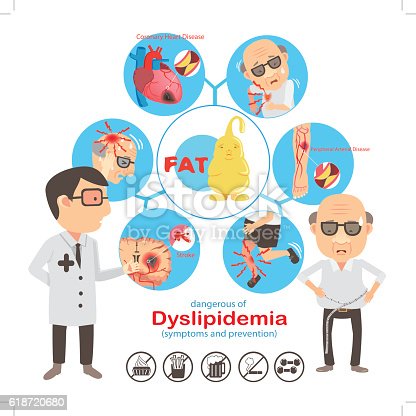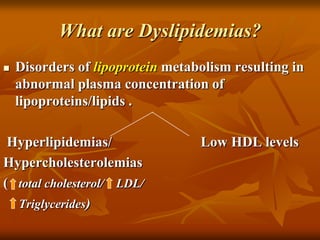
The term "dyslipidemia" refers to a condition where the body has unhealthy levels of lipids, primarily LDL and triglycerides. It can also refer to low levels of HDL, or "good" cholesterol. While LDL is considered the bad cholesterol, it can also accumulate into clumps in the arteries, causing plaque. In contrast, HDL is considered the "good" cholesterol, and it helps remove LDL from the bloodstream.
Dyslipidemia is a broad term that can mean several things. It is a condition that causes elevated blood triglycerides and low levels of high-density lipoprotein cholesterol. However, it is important to note that both of these conditions can be treated with lifestyle changes and medication. This article will discuss the different types of dyslipidemia and what you can do to control them. The condition may be caused by many factors, including obesity, unhealthy eating, and a sedentary lifestyle.
While many people suffer from dyslipidemia, the condition can also be inherited. If your parents or grandparents were diagnosed with dyslipidemia, you may be at a higher risk. This is called heterozygous familial hypercholesterolemia. In children, there are no symptoms to identify this disorder. If you’re suffering from the symptoms of dyslipidemia, it is advisable to talk with your doctor to diagnose and treat your condition.
Diagnosing and treating dyslipidemia is essential for maintaining good health. At the Mercy Medical Center, your doctor will help you identify the causes of your disease and help you choose the best treatment. They will also educate you on how to lead a healthier lifestyle, which will reduce the risk of cardiovascular disease. It’s important to know that high levels of cholesterol are linked to an increased risk of heart disease and stroke. The good news is that there’s no reason to live with this condition.
For those who have high cholesterol levels, it is important to know the correct way to lower them. The European Society of Cardiology and the European Atherosclerosis Society have established guidelines for healthy cholesterol and have even defined what constitutes a healthy level of HDL and LDL. This means that you should be aware of your cholesterol levels and how they affect your health. The ideal cholesterol level for a healthy person is less than 20 mg/dl, but it should be above 70mg in both men and women.

If your family history of high cholesterol is positive, a lipid panel will be recommended. This test will determine how much LDL, HDL, and triglycerides are in your blood. A lipid panel is often the only way to diagnose dyslipidemia, as treatment is often limited to modifying your diet and lifestyle. The best way to treat dyslipidemia is to follow your doctor’s recommendations and avoid the risk of cardiovascular disease.
The lipid panel is a screening test that measures the level of LDL cholesterol and HDL cholesterol in the blood. It will show if there are xanthomas on the body and if the level is too high or too low. There is usually no treatment for this type of dyslipidemia unless it is too severe. In some cases, a change in diet may be required. If the condition is uncontrollable, site https://duydam.com/
recommends over-the-counter fat-soluble vitamin supplements.
Although dyslipidemia is a serious health problem, many people don’t realize how common it is. The disease is caused by a combination of obesity, a sedentary lifestyle and an unhealthy diet. In addition to diet, lifestyle and exercise, it can also be inherited. For example, a family member with high LDL cholesterol may also have the disease. Also, a doctor may recommend a lower LDL level if your family has a family history of the condition.
With diagnosed dyslipidemia, treatment is primarily aimed at preventing atherosclerotic heart disease. Treatment for dyslipidemia depends on the type of dyslipidemia. Patients with this condition should carefully follow their doctor’s advice to prevent any side effects. In addition to lowering LDL levels, this condition also reduces the risk of cardiovascular disease. And while the disease can be managed, proper diet and exercise can reduce the risk of cardiovascular disease.